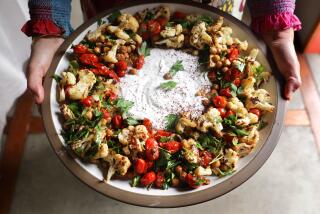California Cook: Chase away post-holiday blues with a pot of long-simmered greens

- Share via
And so we enter our greens days. When the weather turns damp and chilly, when a surfeit of holiday festivities has you feeling spent and lethargic, there is nothing like a pot of long-simmered greens to warm you and fill your empty spaces.
My wife and I regularly pick up a bucket of them from Johnny Rebs’ barbecue stand (the ‘cue is pretty good; the sides are outstanding). A big bowl with some crumbled corn bread is about as good a winter dinner as I can imagine.
But as delicious and soul-satisfying as greens are stewed with smoked pork, there are many other ways to cook them. Here are a few of my favorites. (You’ll find full recipes for all of them and more in our online California Cookbook, recipes.latimes.com.)
Kale, collards, chards, mustards, dandelions, even turnip and beet greens each have their own distinct personality, but they can be used more or less interchangeably. The result will be different in character but still delicious. Choose whatever looks best at the market or, preferably, a combination of as many as you can find.
The packages of already chopped greens mixes are a convenience but tend to be a little sloppily sorted for my taste. Poke through and toss as many of the woody stems as possible. If you’re starting from scratch with whole leaves, trim the stem to the point that it becomes easily flexible.
It may seem paradoxical, but fresh greens are actually at their best after they’ve been cooked for a while. The color fades, true, but the flavor, which can be a bit harsh and bitter when raw, mellows to become sweet and complex, and the texture becomes silky.
One thing to be aware of: Greens shrink incredibly during cooking. What might seem like a sinkful when you wash them will wilt quickly when you heat them. The best way to cook greens is by the handful. Use a wide pan to accommodate as many as possible, and add another handful only after the first has reduced.
Once you’ve cooked the greens low and slow until they’re almost melting, you can start playing with the flavorings.
Collard greens with roasted peanuts and crushed red peppers: Add peanuts you’ve toasted in oil to blanched greens flavored with lots of garlic and chile.
Greens with crisped bread crumbs: Toast bread crumbs in olive oil to add crunch to blanched greens.
Swiss chard with golden raisins and lemon bread crumbs: Toast the bread crumbs with lemon zest, and add them and soaked raisins to greens you’ve braised to sweet silkiness.
Greens with spicy lemon-cumin oil: Make an aromatic oil by warming olive oil with cumin seeds, red pepper and lemon zest. Add this a teaspoon or so at a time to braising greens so they absorb the flavor slowly.
Quesadillas stuffed with greens and feta: Fry corn tortillas you’ve stuffed with braised greens and feta or goat and mozzarella cheeses.
Pot herb soup: Simmer tough greens and potatoes until they’re tender, then finish with tender greens such as spinach or arugula.
Southern comfort soup: This is my go-to when the flu calls. Simmer shredded greens and lots of garlic, then stir in cooked rice. A bit of sherry vinegar and a happy grating of Parmigiano at the end makes all the difference.
Follow me @russ_parsons1
More to Read
Eat your way across L.A.
Get our weekly Tasting Notes newsletter for reviews, news and more.
You may occasionally receive promotional content from the Los Angeles Times.










